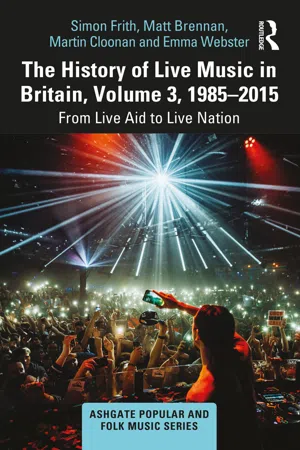
The History of Live Music in Britain, Volume III, 1985-2015
From Live Aid to Live Nation
- 274 pages
- English
- ePUB (mobile friendly)
- Available on iOS & Android
The History of Live Music in Britain, Volume III, 1985-2015
From Live Aid to Live Nation
About this book
To date there has been a significant gap in existing knowledge about the social history of music in Britain from 1950 to the present day. The three volumes of Live Music in Britain address this gap and do so through a unique prism—that of live music. The key theme of the books is the changing nature of the live music industry in the UK, focused upon popular music but including all musical genres. Via this focus, the books offer new insights into a number of other areas including the relationship between commercial and public funding of music; changing musical fashions and tastes; the impact of changing technologies; the changing balance of power within the music industries; the role of the state in regulating and promoting various musical activities within an increasingly globalised music economy; and the effects of demographic and other social changes on music culture. Drawing on new archival research, a wide range of academic and non- academic secondary sources, participant observation and a series of interviews with key personnel, the books have the potential to become landmark works within Popular Music Studies and broader cultural history. The third volume covers the period from Live Aid to Live Nation (1985– 2015).
Frequently asked questions
- Essential is ideal for learners and professionals who enjoy exploring a wide range of subjects. Access the Essential Library with 800,000+ trusted titles and best-sellers across business, personal growth, and the humanities. Includes unlimited reading time and Standard Read Aloud voice.
- Complete: Perfect for advanced learners and researchers needing full, unrestricted access. Unlock 1.4M+ books across hundreds of subjects, including academic and specialized titles. The Complete Plan also includes advanced features like Premium Read Aloud and Research Assistant.
Please note we cannot support devices running on iOS 13 and Android 7 or earlier. Learn more about using the app.
Information
1New times
Above me the sky was blue. The sun seemed at its zenith and it filled the stadium with the brilliant untainted light of an English summer’s day … Before me was the largest audience the world has ever known … This was 13 July 1985. It was Live Aid.(Bob Geldof 1986:10)
So what exactly is Red Wedge? Is it a cynical device via which the Labour Party hopes to get the vital youth vote for a general election now just over two years away? A front for a faction like Militant? A Live Aid for Lefties? An ideologically sound haircut?(New Musical Express January 18, 1986: 19)
Mass production, the mass consumer, the big city, big-brother state, the sprawling housing estate, and the nation-state are in decline: flexibility, diversity, differentiation, mobility, communication, decentralisation and internationalisation are in the ascendant. In the process our own identities, our sense of self, our own subjectivities are being transformed. We are in transition to a new era.(Stuart Hall (1988: 24)
Introduction
The traditional relationship was one in which the LP or CD was the focus, with concerts primarily there to sell more records. In today’s downloadable world, where the price of music has tumbled, and in some cases is even given away free, records, CDs and downloads have been demoted to the status of promotional tools for selling tickets and merchandise. Album sales are in meltdown. Much of the action is moving to the live arena. Live music has become a key route to profitability.(quote taken from Evening Standard, 10 September 2008: 21)
In the past, when greater concert attendance translated into greater artists’ record sales, artists had an incentive to price their tickets below the profit-maximising price for concerts alone. New technology that allows many potential customers to obtain recorded music without purchasing a record has severed the link between the two products. As a result, concerts are being priced more like single-market monopoly products.(Krueger 2005: 1, 25–26)
They [record labels] were the powerful people, they controlled all the money, they controlled all the tools. They could make groups successful by spending lots of money marketing them. And so we used to listen to what they had to say. But I remember one classic moment when Virgin Records said to me, “You’re doing the Iggy Pop tour before the album’s released” and I said, “Who cares about a new Iggy Pop album? They’re playing to people who want to hear The Passenger.” And the swing in power between record companies and live music has been incredible.5
Red Wedge
This shift impacted especially on young people since many of the jobs that disappeared were the less skilled manual occupations that had been the bedrock of youth employment during the fifties and sixties [and, we would add, the underpinning of the rise of rock ‘n’ roll...
Table of contents
- Cover
- Half Title
- Series Information
- Title Page
- Copyright Page
- Dedication
- Contents
- Preface
- Acknowledgements
- 1 New times
- 2 We Are the World
- 3 Taking care of business
- A snapshot of live music in Bristol in October–November 2007
- 4 Live music and the state
- 5 The political economy of music festivals
- 6 Festival worlds
- A snapshot of live music in Glasgow in October–November 2007
- 7 DJ business
- 8 Moving to a different beat: jungle, bhangra, garage and grime
- 9 Making a musical living
- A snapshot of live music in Sheffield in October–November 2007
- 10 Live music experience in the digital age
- 11 The live music ecology
- The Rolling Stones, Twickenham, August 20 and 22, 2006
- 12 Conclusion: the value of live music
- Bibliography
- Index